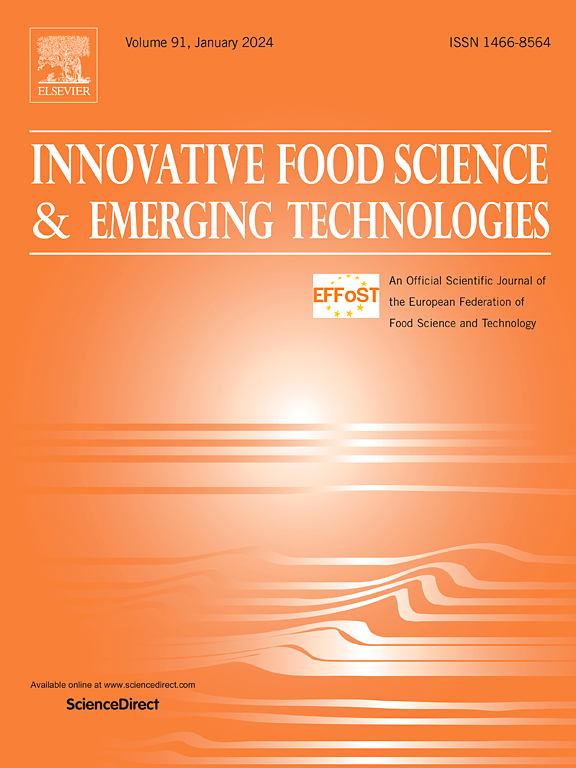Pulsed electric field pretreatment for energy efficient processing of industrial peach cultivars
IF 6.3
1区 农林科学
Q1 FOOD SCIENCE & TECHNOLOGY
Innovative Food Science & Emerging Technologies
Pub Date : 2025-01-12
DOI:10.1016/j.ifset.2025.103931
引用次数: 0
Abstract
Extraction of peach juice is commonly performed with centrifugal paddle mesh extractors, scraping peaches against meshes after destoning to separate peels and residual stone pieces from pulp. Late season peaches are notorious for their hard texture, complicating comminution processes and leading to low juice yields. To avoid this, thermal treatments are employed, resulting in juice quality deterioration and increased energy consumption. Pulsed Electric Fields (PEF) rely on electroporation of plant tissues to soften them and increase extraction yields. This research explores the effect of PEF (0.5–2.0 kV/cm, specific energy 0–12 kJ/kg) on peach fruit texture, juice yield and quality, compared to thermal treatments. Peach juice yield was non-monotonically dependent on treatment intensity. Maximum juice yield of 70 % was achieved with 0.6 kJ/kg specific energy, compared to untreated peaches exhibiting a juice yield of 65 %. The specific energy input required for PEF treatment was equal to 0.31 % of the corresponding value for a thermal blanching (195 kJ/kg). The juice obtained from blanched peaches exhibited significant discoloration. Conclusively, PEF pretreatment provides substantial energy savings by rendering the juicing process of problematic crops such as peaches highly efficient and sustainable.
脉冲电场预处理在工业桃源节能加工中的应用
桃汁的提取通常是用离心桨网提取器进行的,在去核后将桃子刮在网上,从果肉中分离出果皮和残余的石块。晚熟桃子因其坚硬的质地、复杂的粉碎过程和低果汁产量而臭名昭著。为了避免这种情况,采用热处理,导致果汁质量恶化和能源消耗增加。脉冲电场(PEF)依靠植物组织的电穿孔来软化它们并提高提取率。研究了与热处理相比,PEF (0.5 ~ 2.0 kV/cm,比能0 ~ 12 kJ/kg)对桃果质构、果汁产量和品质的影响。桃汁产量与处理强度呈非单调关系。与未经处理的65%的果汁产量相比,在0.6 kJ/kg比能量的情况下,最大果汁产量达到70%。PEF处理所需的比能量输入相当于热漂相应值(195 kJ/kg)的0.31%。从焯过的桃子中得到的果汁表现出明显的变色。最后,PEF预处理通过使有问题的作物如桃子的榨汁过程高效和可持续,提供了大量的能源节约。
本文章由计算机程序翻译,如有差异,请以英文原文为准。
求助全文
约1分钟内获得全文
求助全文
来源期刊
CiteScore
12.00
自引率
6.10%
发文量
259
审稿时长
25 days
期刊介绍:
Innovative Food Science and Emerging Technologies (IFSET) aims to provide the highest quality original contributions and few, mainly upon invitation, reviews on and highly innovative developments in food science and emerging food process technologies. The significance of the results either for the science community or for industrial R&D groups must be specified. Papers submitted must be of highest scientific quality and only those advancing current scientific knowledge and understanding or with technical relevance will be considered.

 求助内容:
求助内容: 应助结果提醒方式:
应助结果提醒方式:


